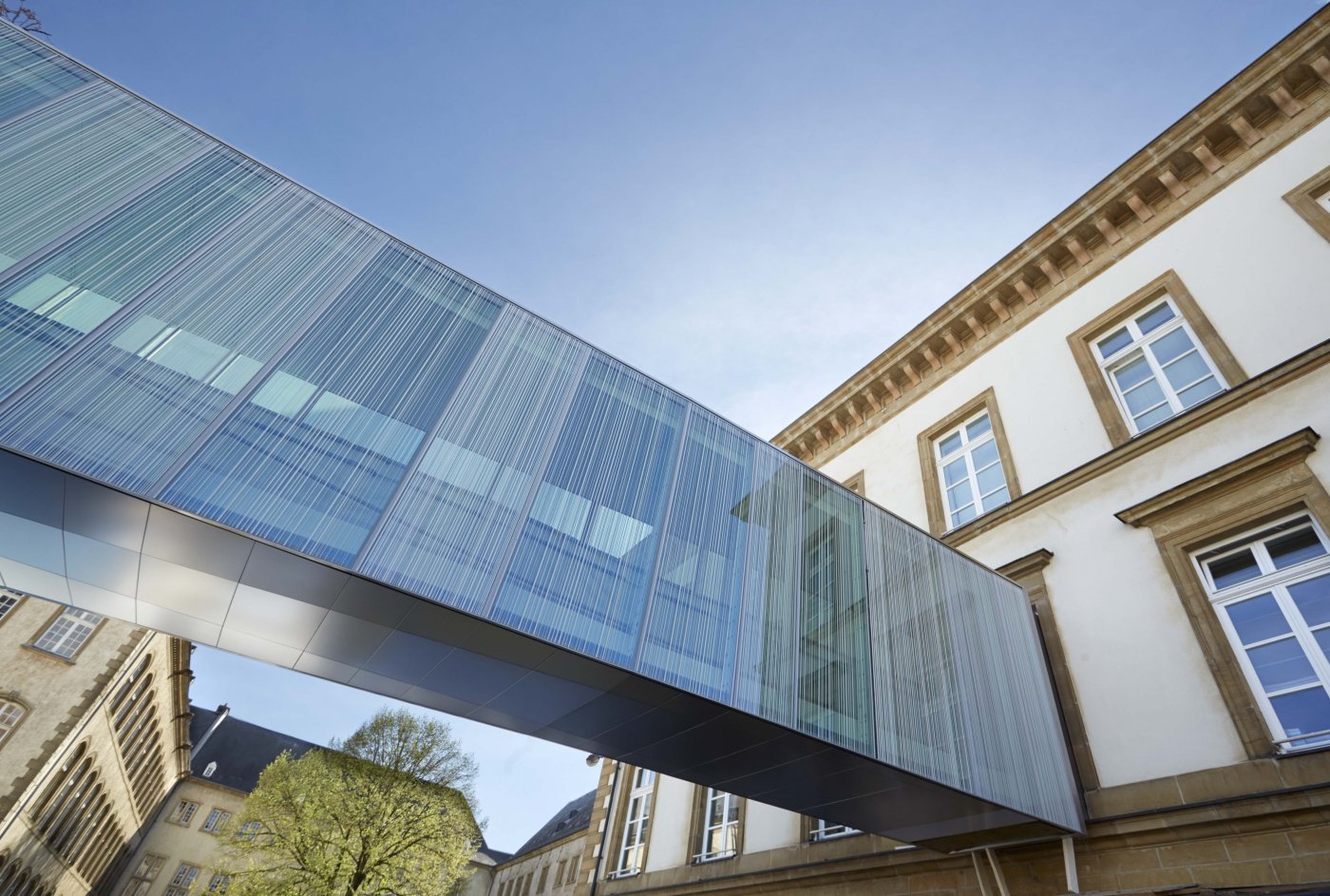Summary record
Video
Traffic in Gasperich
QUESTION BY MARC ANGEL
Since 3 August 2017, work has been undertaken to reduce through traffic in the area of Aal Gasperich. Rue Franz Liszt, Rue Christophe Colomb and Rue Georges Clemenceau have been made one-way streets as part of these efforts. Rue Christophe Colomb has been blocked off between Rue Richard Wagner and Rue Père Raphaël.
Following these changes, the already intense traffic in Rue Beethoven as well as in nearby streets has considerably increased. Moreover, the residents of the Giorgetti area in Gasperich have launched a petition so that a solution can be found to remedy the increase in through traffic. According to my information, a delegation of petitioners has already been received by the Mayor. With this in mind, I would like to ask the following questions:
- Does the Mayor share the petitioners' view that there should be no direct links between a residential neighbourhood and an industrial zone?
- Does the Mayor share the petitioners' view that the redevelopment in the area of Aal Gasperich is a stopgap response that does not provide an adequate solution to the problem of through traffic that exists more generally in the Gasperich district and which could increase even more with the finalisation of the Ban de Gasperich development project?
- It seems that, at this meeting, a promise was made to count the cars passing through the Giorgetti area. Was this count ever carried out? What were the results?
- What solution does the Mayor propose to reduce through traffic?
QUESTION BY SAM TANSON
The mission statement of the College of Aldermen states that "efforts to alleviate commuter traffic within residential districts will be continued". With regard to the discussions surrounding the aldermen's mission statement, on which I have already requested details, without success, I would like to put the following question to the College of Aldermen:
- Bearing in mind that the previous College of Aldermen had decided, following consultation with the local residents, upon measures to reduce traffic in certain streets in Gasperich. These measures were supposed to be temporary as an evaluation was planned. Was this evaluation ever carried out? If so, what were its results? Are these measures going to be permanent?
- Given that when these measures were first implemented, through traffic shifted at first toward the so-called Giorgetti area, what was the result of the traffic count in these streets? Assuming that an increase in traffic has been confirmed, what measures are being taken by the College of Aldermen? Will a meeting with the residents of the entire district be organised to discuss what measures to take, as was the case for the previous measures?
RESPONSE BY PATRICK GOLDSCHMIDT
Alderman Goldschmidt confirmed that several meetings on the issue have taken place with local residents, and that a series of measures were taken in 2017 to reduce traffic in this area. These measures were provisional and a report was to be prepared within six months. There was a large meeting of local residents in March 2018. At that meeting, it was confirmed that the direction of traffic in Rue Aristide Briand would change, and that, for the increase in traffic, final measures were decided upon. The residents of the streets in the Giorgetti area complained of excessive traffic following efforts to reduce traffic in other streets.
The traffic counts showed that there was a slight increase in the number of cars passing through during rush hour. The results of the count were presented to the local residents of the Giorgetti area at the large district meeting in March 2018, and a proposal was made to close Rue Gluck, but the majority of residents were against that measure, arguing in favour of businesses. Finally, it was decided that this street would remain accessible for the time being, and that something could still be done to reduce the traffic when Rue Darwin opens, foreseeably before the collective leave period. The situation will still need to be evaluated and a decision will need to be taken on whether to reopen Rue Christophe Colomb, which is currently closed.
The proposal to reroute buses to Route d'Esch was not pursued, since this could result in fewer people using public transportation. There was no second informational meeting for the neighbourhood as a whole, but only for the local residents of the streets targeted for redevelopment. The new proposals are currently being analysed.
Snow removal and salting
QUESTION BY FRANÇOIS BENOY
In the case of persistent freezing and snow, the public authorities must take steps to ensure safety on roads, pavements and in public places. The easy solution is salting, but this has a negative impact on the soil, plants, the water table, domestic and wild animals, bicycles, vehicles, shoes, etc. To reduce the negative impact of the use of salt, differentiated snow removal involves the evaluation of each given situation (condition and use of the roads, weather conditions, etc.). to efficiently clear the streets and reduce the use of salt.
- Having observed on several occasions in December that the City of Luxembourg used salt for snow removal without ploughing first, could you please specify the instructions given to the teams in question? To what extent is differentiated snow removal applied?
- How has the consumption of salt for snow removal changed in recent years? What measures have been taken to reduce such use? Has the department concerned, for example, ever used anti-slip (traction) products instead of anti-ice products?
- Does the snow removal department team clear snow from the streets in public places in any specific order? By what criteria is this order evaluated regularly?
RESPONSE BY PATRICK GOLDSCHMIDT
Alderman Goldschmidt replied that the snow removal operations carried out last winter were no different from those carried out in previous years. In 2010, the College of Aldermen came to a decision on which streets would be given priority for snow clearing and, within the confines of Luxembourg, this task is undertaken by the Service Voirie (Roads Department). For roads outside the City, an arrangement has been reached with the National Roads Administration. If the snow is less than 5 cm deep, it is not removed. Two weather stations provide information based on which the amount of salt to spread is calculated.
In recent years, the amount of salt used has declined by 30% and efforts have been made to improve this rate even more. Moreover, sensors installed on the trucks are used to calculate the amount of salt required. In 2015, the members of the Bausch and Dieschbourg government, in an answer to a parliamentary question, stated that salt does not have a detrimental effect on plants and animals. It takes about four hours to clear snow from the 400 km of roads in the City, depending on the determined order of priority.
The Service Parcs (Parks Department) has tried using anti-skid products in certain places, but the results were less than promising. As these products do not melt snow, the snow must first be cleared, and then afterwards, the anti-skid products as well. In much the same way, the use of sand and similar products in the 1980s was discontinued because these products damage cars. It is true that in Ban de Gasperich, our teams forgot about removing snow from a bicycle path, but an arrangement was found with the National Roads Administration.
Implementation of a program to help children with their homework
QUESTION BY CLAUDINE KONSBRUCK
The mission statement of the College of Aldermen of December 2017 declares that a homework assistance programme for primary school children on Tuesday and Thursday afternoons will be rolled out across the city. The City of Luxembourg, as the largest municipality in the country, with its diverse and international population, must play a leading role in this area. I would like information on the College of Aldermen's specific projects in this regard.
- What are the City's intentions?
- Is there one or several models that could inspire the City?
- What is the foreseeable schedule for the implementation of the programme?
RESPONSE BY COLETTE MART
Alderwoman Mart responded that across the city, parents hope that homework is completed by the time their children get home, especially since, for parents coming from foreign countries, language barriers often prevent them from helping their children. Help with homework is one way to promote equal opportunities in schools, and guided study sessions are offered on Mondays, Wednesdays and Fridays from 11:40 to 12:30 under the supervision of a teacher.
Two projects were launched: one in Bonnevoie, in the building in Rue Demy Schlechter, where teachers provide assistance on Tuesday and Thursday afternoons; and a second in Cents, in partnership with an association, a number of students and the school committee. In the mean time, a retired teacher and an educator help once per week, and students from the University of Luxembourg also take help out in the child care centres.
The plan is to further develop these approaches by introducing other models so that the service can be made available in all Luxembourg City districts in collaboration with the Service Enseignement (Education Department), the Service Foyers scolaires (Childcare Department), the Comité de cogestion (co-management committee) and the direction régionale (regional directorate). One option would be to use retired teachers and students. These issues will soon be addressed by the new head of the Service Enseignement, who took over when his predecessor retired.
Pilot project for gifted children
QUESTION BY SAM TANSON
In the 2015-2016 school year, a pilot program for gifted children was launched in the schools of Luxembourg City. These children can take weekly classes adapted to their needs at the Rollingergrund school. Extensive work to prepare for and specialise in this area preceded the implementation of the project. There is information circulating that a decision has been taken to suspend the Rollingergrund pilot programme. In a response to a parliamentary question, the Minister of Education nonetheless wrote on 25 July 2016 that his department had accepted a request to increase resources for the 2016-2017 school year. In the same response, the Minister wrote that an evaluation of the project was currently in progress: the children involved and their parents had been asked to complete a questionnaire that would soon be evaluated by the members of a working group in charge of monitoring the project. He continued to say that support from the Department for the Coordination of Educational and Technological Research and Innovation (SCRIPT) was also expected. It would thus be too soon to try to draw any final conclusions.
In light of this, I would like to ask the following questions:
- How many children are currently taking classes as part of the pilot project?
- Will the project be terminated or maintained beyond the current school year?
- If the answer is yes, what will be the relationship between the monitoring centre for intellectually precocious children and youths that is to be created, further to the draft law on the creation of specialised education centres to promote inclusive education (no. 7181), and the pilot project?
- If the answer is no, what will be offered to the children concerned during their class time from the beginning of the 2018-2019 school year?
- What are the results of the evaluation mentioned in the minister's response?
RESPONSE BY COLETTE MART
Alderwoman Mart replied that the pilot project was launched by the City in 2016, and that the children involved are divided into two groups: one with four children in Cycles 2.1 to 3.1, and another with nine children in Cycles 3.2 to 4.2. This pilot project was well received by the parents and also by the media. The children involved are identified by their teachers and taken out of their classes for several hours for separate instruction. The children are considered as having "special needs" since they are often bored in their normal classrooms.
The Ministry of National Education would like to create competence centres in which a global approach is taken, and adaptations will be made to the education of these children, who will be regularly monitored. This means that, at the beginning of the 2018/2019 school year, the City will not have the necessary personnel to continue to pilot project. In actual fact, it is the ministry that is responsible for assigning the teaching staff who work in the country's various municipalities.
The College of Aldermen, the Service Enseignement and the Regional Directorate would like to continue providing this service in Luxembourg City and, accordingly, have sent a letter to the minister requesting a meeting. If the pilot project cannot continue in Luxembourg City, the children involved will be included in the competence centre programme. The minister has not yet responded, but it might be possible that additional information will be provided when the organisation of the school system is presented.
Deliveries and the heavy vehicle traffic plan in the Gare district once the tram is operating in this area
QUESTION BY HÉLOISE BOCK
During the recent presentation of the segment of the tram line on the Avenue de la Liberté to the City's Commission du développement urban (Urban Development Committee), I enquired as to where deliveries for businesses along Avenue de la Liberté, including Place de Paris, would be made. I would like to ask you the same question again, given that an answer was not provided by the representatives of Luxtram S.A. at the above-mentioned meeting.
According to unofficial information in my possession, I understand that it is planned that deliveries for the businesses on Avenue de la Liberté and Place de Paris will be made from delivery stations located on Rue Glesener. If that is so, it would pose a major problem in many respects and for many different groups of people, i.e. business owners, pedestrians and, last but not least, the residents of the Gare district.
First, businesses requiring unbroken cold chain deliveries cannot receive deliveries that must be transported by foot over distances of several tens or even hundreds of meters since the cold chain would be broken.
In addition, the quantities that need to be delivered to the many businesses located in Avenue de la Liberté and Place de Paris are quite significant. There is also the question of how it would even be possible to transport the required quantities of products on palettes across a pavement that is narrow without interfering with pedestrian traffic, for which the pavement is theoretically intended.
Last but not least, the Gare district is one of the most densely populated districts in the City, and the issue of preserving the peace and quiet of the residential part of the Gare district also needs mentioning. In fact, if delivery and moving trucks and other types of trucks must, in the future, park in Rue Glesener, it would mean that the trucks would have to transit via residential streets in the Gare district (i.e. Boulevard Marx, Rue d'Anvers, Rue Adolphe Fischer next to the school and then Rue Glesener, or Rue de Strasbourg, Rue Adolphe Fischer and then Rue Glesener - all very residential streets). It would be very unfortunate if having a tram stop in the Gare district were to give rise to a situation where road traffic, including heavy delivery vehicles and moving trucks, is reduced on the main arteries only to be rerouted to the residential part of the Gare district. Such an approach seems unacceptable.
- Can this question be urgently analysed with the government departments concerned so that a solution can be found that meets the expectations of all residents and businesses in the Gare district (including during the construction phase of the tram)?
- Can the problem of deliveries in the other parts of the Gare district be examined in order to prevent the same problems arising as those mentioned above regarding deliveries in Avenue de la Liberté?
- Is it possible to analyse all of the different deliveries made in the Gare district with a view to optimising the delivery routes, reducing unloading times to a minimum, and preventing trucks from transiting via residential streets and disturbing the peace of the residents of the Gare district?
- In concrete terms, does the two-way bicycle path that is planned in Avenue de la Liberté, between Place de Paris and Place de la Gare, have to be rerouted to Avenue de la Gare via Rue Jean Origer? Otherwise, if there are two traffic lanes (?), can a traffic lane on Avenue de la Liberté be reserved for deliveries between, for example, 9:00 and noon every day (assuming that the authorities are able to monitor compliance with the prohibition the rest of the time)?
- Is it possible to make sure that Place de Paris does not lose its appeal as a public space by becoming a parking area for delivery trucks and other vehicles?
- Is it possible to prohibit heavy trucks from using the residential streets in the Gare district?
RESPONSE BY PATRICK GOLDSCHMIDT
Alderman Goldschmidt replied that, when the tram stop is completed, four delivery parking spots in Avenue de la Liberté – i.e. two on each side of the street between the Place de la Gare and Rue de Strasbourg – will disappear.
Delivery parking spots are planned at Place de Paris, Rue Glesener and Rue de Strasbourg since trucks must obviously be able to access these streets to make deliveries.
In compliance with the traffic code, it will be examined how transit traffic can be rerouted to allow safe deliveries at certain times. More generally, traffic reduction measures are planned for the Gare district.
The Commission de la mobilité urbaine (Urban Transport Committee) will be informed about the expected traffic flows.
CCTV in Luxembourg City
QUESTION BY FRANÇOIS BENOY
On the issue of CCTV in Luxembourg City, Councillor Benoy raised a number questions in his letter dated 15 March 2018:
- Where in the City are CCTV cameras currently installed, and what plans are there regarding the introduction of CCTV in the Gare district?
- What expectations are there as regards CCTV, given that the CCTV cameras that were introduced as part of the VISUPOL project proved ineffective in preventing crime, which simply shifted to other parts of the City where there were no cameras?
- Are there any plans to introduce CCTV in other City districts?
- Finally, how many times has the task force met over the past 6 months, and what measures have been considered?
QUESTION BY MAURICE BAUER
In application of the municipal council's rules of procedure, Councillor Bauer would like to put the following questions to the college of aldermen (letter dated 18 April 2018):
In a statement in the RTL news broadcast last Sunday, the Vice Prime Minister and Minister of Internal Security declared that discussions were being held with the City of Luxembourg on the subject of extending CCTV even further in the Gare district to reinforce the feeling of safety and security among the district's residents.
- In the wake of this public statement, could you please inform the municipal council as to the progress of the discussions?
- What are the specific locations targeted by this extension of CCTV, since the minister, in his statement, spoke of "am Garer quartier iwerall"?
- Do the discussions also cover an extension of monitoring in adjacent districts, in particular Bonnevoie, since CCTV often leads some people who do not like to be monitored to leave?
- To allow the forces of law and order to show a more visible physical presence in this district, and thus reinforce the feeling of safety and security among the district's residents, do you know whether the number of police officers assigned to Luxembourg City has increased in proportion with the growth of the population in recent years (rise of more than 30% in the last 10 years)?
RESPONSE BY LYDIE POLFER
The Mayor replied that currently there is video monitoring of the area in front of the train station, on the Kinnekswiss and a portion of the Glacis, as well as around the Josy Barthel Stadium. Video monitoring is also planned for the passageway under the Pont Aldolphe, and this was discussed at the meeting of the Comité de prévention communal (Municipal Prevention Committee) on 16 March 2018. The committee declared that it was in favour of extending CCTV to the zone around the school in Rue de Strasbourg, since drugs are sold in this area.
The Ministry of Internal Security asked the City to inform the population of the planned extension in order to seek its opinion, and an information meeting is planned for 31 May at 19:00 in the sports hall of the school in Rue de Strasbourg.
The police pointed out that VISUPOL video monitoring allows them to retrace events and identify perpetrators, and that CCTV also has a dissuasive effect on crime in other streets. They also pointed out that the greatest number of incidents in Luxembourg City take place in the Gare district.
Following the above mentioned meeting on 31 May, it will be determined whether further extensions can be envisioned. As the increase in the number of police officers has not kept up with the increase in the population, the reopening of a neighbourhood police station in the Gare district was well received. It is clear that, in addition to the available monitoring resources, more police officers are needed in this district to fight crime.
The Roll and Run fun race as part of the ING marathon
QUESTION BY TOM KRIEPS
It appears that a race called "Roll and Run", for people with reduced mobility, is being planned as part of the City of Luxembourg ING marathon.
The company Step by Step, which is organising the run, declared that it was not able to hold this event for technical reasons, due to the fact that the Tram rails would not be covered and would present a danger for the participants crossing the rails.
- Is the City of aware of these facts, and if so, how can it guarantee the participation of people with reduced mobility?
- Have these problems already been discussed with the company Luxtram?
RESPONSE BY SIMONE BEISSEL
Alderwoman Beissel replied that there are two tram-rail crossing points that can be used by wheelchair users, and that the Service intégration et besoins spécifiques (Integration and Special Needs Department) has raised the matter with Luxtram, which has promised to find a solution and conduct a test to make sure that wheelchair users can cross safely.













